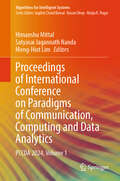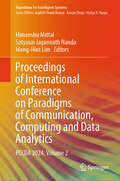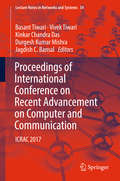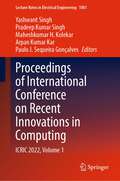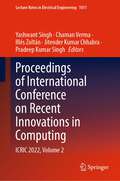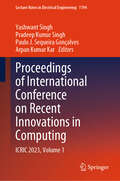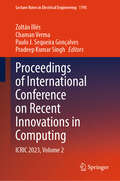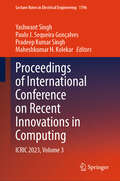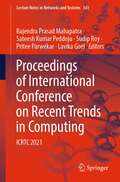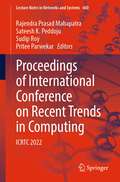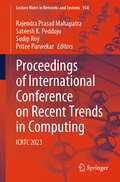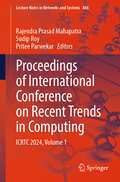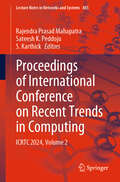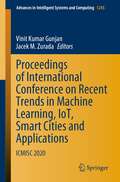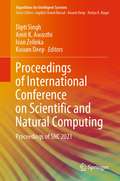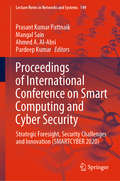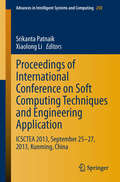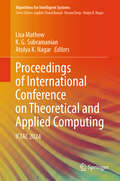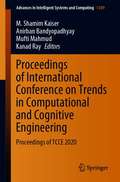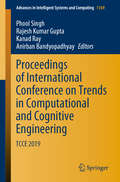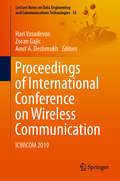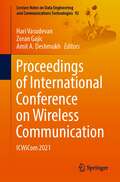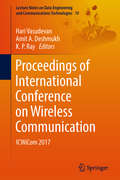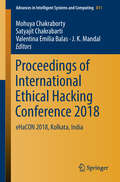- Table View
- List View
Proceedings of International Conference on Paradigms of Communication, Computing and Data Analytics: PCCDA 2024, Volume 1 (Algorithms for Intelligent Systems)
by Meng-Hiot Lim Satyasai Jagannath Nanda Himanshu MittalThis book is a collection of selected high-quality research papers presented at the International Conference on Paradigms of Communication, Computing and Data Analytics (PCCDA 2024), held at Pt. Lalit Mohan Sharma Campus, Rishikesh, Sri Dev Suman Uttarakhand University, Uttarakhand, India, during 20–21 April 2024. It discusses cutting-edge research in the areas of advanced computing, communications and data science techniques. The book is a collection of the latest research articles in computation algorithm, communication and data sciences, intertwined with each other for efficiency.
Proceedings of International Conference on Paradigms of Communication, Computing and Data Analytics: PCCDA 2024, Volume 2 (Algorithms for Intelligent Systems)
by Meng-Hiot Lim Satyasai Jagannath Nanda Himanshu MittalThis book is a collection of selected high-quality research papers presented at the International Conference on Paradigms of Communication, Computing and Data Analytics (PCCDA 2024), held at Pt. Lalit Mohan Sharma Campus, Rishikesh, Sri Dev Suman Uttarakhand University, Uttarakhand, India, during 20–21 April 2024. It discusses cutting-edge research in the areas of advanced computing, communications and data science techniques. The book is a collection of the latest research articles in computation algorithm, communication and data sciences, intertwined with each other for efficiency.
Proceedings of International Conference on Recent Advancement on Computer and Communication: Icrac 2017 (Lecture Notes In Networks And Systems #34)
by Durgesh Kumar Mishra Basant Tiwari Vivek Tiwari Kinkar Chandra Das Jagdish C. BansalThe book is a compilation of best papers presented at International Conference on Recent Advancement in Computer and Communication (ICRAC 2017) organized by IMPLab Research and Innovation Foundation, Bhopal, India. The book covers all aspects of computers and communication techniques including pervasive computing, distributed computing, cloud computing, sensor and adhoc network, image, text and speech processing, pattern recognition and pattern analysis, digital signal processing, digital electronics, telecommunication technologies, robotics, VLSI technologies, embedded system, satellite communication, digital signal processing, and digital communication. The papers included are original research works of experts from industry, government centers and academic institutions; experienced in engineering, design and research.
Proceedings of International Conference on Recent Innovations in Computing: ICRIC 2022, Volume 1 (Lecture Notes in Electrical Engineering #1001)
by Arpan Kumar Kar Pradeep Kumar Singh Maheshkumar H. Kolekar Yashwant Singh Paulo J. Sequeira GonçalvesThis book features selected papers presented at the 5th International Conference on Recent Innovations in Computing (ICRIC 2022), held on May 13–14, 2022, at the Central University of Jammu, India, and organized by the university’s Department of Computer Science and Information Technology. The conference was hosted in association with ELTE, Hungary; Knowledge University, Erbil; Cyber Security Research Lab and many other national & international partners. The book is divided into two volumes, and it includes the latest research in the areas of software engineering, cloud computing, computer networks and Internet technologies, artificial intelligence, information security, database and distributed computing, and digital India.
Proceedings of International Conference on Recent Innovations in Computing: ICRIC 2022, Volume 2 (Lecture Notes in Electrical Engineering #1011)
by Pradeep Kumar Singh Jitender Kumar Chhabra Yashwant Singh Chaman Verma Illés ZoltánThis book features selected papers presented at the 5th International Conference on Recent Innovations in Computing (ICRIC 2022), held on August 13–14, 2022, organized by the ELTE, Hungary in association with Knowledge University, Erbil and many academic and industry partners which includes; European Institute of Data Analytics (EiDA), Dublin, Ireland and CSRL Lab, India . The book is second part of the two volumes, and it includes the latest research in the areas of software engineering, cloud computing, computer networks and Internet technologies, artificial intelligence, information security, database and distributed computing, and digital India.
Proceedings of International Conference on Recent Innovations in Computing: ICRIC 2023, Volume 1 (Lecture Notes in Electrical Engineering #1194)
by Arpan Kumar Kar Pradeep Kumar Singh Yashwant Singh Paulo J. Sequeira GonçalvesThis book features selected papers presented at the 6th International Conference on Recent Innovations in Computing (ICRIC 2023), held on 26–27 October 2023 at the Central University of Jammu, India, and organized by the university’s Department of Computer Science and Information Technology. The book is divided into two volumes, and it includes the latest research in the areas of software engineering, cloud computing, computer networks and Internet technologies, artificial intelligence, information security, database and distributed computing, and digital India.
Proceedings of International Conference on Recent Innovations in Computing: ICRIC 2023, Volume 2 (Lecture Notes in Electrical Engineering #1195)
by Pradeep Kumar Singh Zoltán Illés Chaman Verma Paulo J. Sequeira GonçalvesThis book features selected papers presented at the 6th International Conference on Recent Innovations in Computing (ICRIC 2023), held on 26–27 October 2023 at the Central University of Jammu, India, and organized by the university’s Department of Computer Science and Information Technology. The book is divided into two volumes, and it includes the latest research in the areas of software engineering, cloud computing, computer networks and Internet technologies, artificial intelligence, information security, database and distributed computing, and digital India.
Proceedings of International Conference on Recent Innovations in Computing: ICRIC 2023, Volume 3 (Lecture Notes in Electrical Engineering #1196)
by Pradeep Kumar Singh Maheshkumar H. Kolekar Yashwant Singh Paulo J. Sequeira GonçalvesThis book features selected papers presented at the 6th International Conference on Recent Innovations in Computing (ICRIC 2023), held on 26–27 October 2023 at the Central University of Jammu, India, and organized by the university’s Department of Computer Science and Information Technology. The book is divided into two volumes, and it includes the latest research in the areas of software engineering, cloud computing, computer networks and Internet technologies, artificial intelligence, information security, database and distributed computing, and digital India.
Proceedings of International Conference on Recent Trends in Computing: ICRTC 2021 (Lecture Notes in Networks and Systems #341)
by Rajendra Prasad Mahapatra Sudip Roy Sateesh Kumar Peddoju Pritee Parwekar Lavika GoelThis book is a collection of high-quality peer-reviewed research papers presented at International Conference on Recent Trends in Computing (ICRTC 2021) held at SRM Institute of Science and Technology, Ghaziabad, Delhi, India, during 4 – 5 June 2021. The book discusses a wide variety of industrial, engineering and scientific applications of the emerging techniques. The book presents original works from researchers from academic and industry in the field of networking, security, big data and the Internet of things.
Proceedings of International Conference on Recent Trends in Computing: ICRTC 2022 (Lecture Notes in Networks and Systems #600)
by Sateesh K. Peddoju Rajendra Prasad Mahapatra Sudip Roy Pritee ParwekarThis book is a collection of high-quality peer-reviewed research papers presented at International Conference on Recent Trends in Computing (ICRTC 2022) held at SRM Institute of Science and Technology, Ghaziabad, Delhi, India, during 3 – 4 June 2022. The book discusses a wide variety of industrial, engineering and scientific applications of the emerging techniques. The book presents original works from researchers from academic and industry in the field of networking, security, big data and the Internet of things.
Proceedings of International Conference on Recent Trends in Computing: ICRTC 2023 (Lecture Notes in Networks and Systems #954)
by Sateesh K. Peddoju Rajendra Prasad Mahapatra Sudip Roy Pritee ParwekarThis book is a collection of high-quality peer-reviewed research papers presented at International Conference on Recent Trends in Computing (ICRTC 2023) held at SRM Institute of Science and Technology, Ghaziabad, Delhi, India, during June 2–3, 2023. The book discusses a wide variety of industrial, engineering, and scientific applications of the emerging techniques. The book presents original works from researchers from academic and industry in the field of networking, security, big data, and the Internet of things.
Proceedings of International Conference on Recent Trends in Computing: ICRTC 2024, Volume 1 (Lecture Notes in Networks and Systems #886)
by Rajendra Prasad Mahapatra Sudip Roy Pritee ParwekarThis book is a collection of high-quality peer-reviewed research papers presented at International Conference on Recent Trends in Computing (ICRTC 2024) organized by SRM Institute of Science and Technology, Ghaziabad, Delhi, India, during July 5–6, 2024. The book is divided into two volumes and discusses a wide variety of industrial, engineering, and scientific applications of the emerging techniques. The book presents original works from researchers from academic and industry in the field of networking, security, big data, and the Internet of Things.
Proceedings of International Conference on Recent Trends in Computing: ICRTC 2024, Volume 2 (Lecture Notes in Networks and Systems #885)
by Sateesh K. Peddoju Rajendra Prasad Mahapatra S. KarthickThis book is a collection of high-quality peer-reviewed research papers presented at the International Conference on Recent Trends in Computing (ICRTC 2024), organized by SRM Institute of Science and Technology, Ghaziabad, held in Delhi, India, from July 5–6, 2024. The book is divided into two volumes and discusses a wide variety of industrial, engineering, and scientific applications of emerging techniques. It presents original works from researchers in academia and industry in the fields of networking, security, big data, and the Internet of Things.
Proceedings of International Conference on Recent Trends in Machine Learning, IoT, Smart Cities and Applications: ICMISC 2020 (Advances in Intelligent Systems and Computing #1245)
by Vinit Kumar Gunjan Jacek M. ZuradaThis book gathers selected research papers presented at the International Conference on Recent Trends in Machine Learning, IOT, Smart Cities & Applications (ICMISC 2020), held on 29–30 March 2020 at CMR Institute of Technology, Hyderabad, Telangana, India. Discussing current trends in machine learning, Internet of things, and smart cities applications, with a focus on multi-disciplinary research in the area of artificial intelligence and cyber-physical systems, this book is a valuable resource for scientists, research scholars and PG students wanting formulate their research ideas and find the future directions in these areas. Further, it serves as a reference work anyone wishing to understand the latest technologies used by practicing engineers around the globe.
Proceedings of International Conference on Scientific and Natural Computing: Proceedings of SNC 2021 (Algorithms for Intelligent Systems)
by Ivan Zelinka Kusum Deep Dipti Singh Amit K. AwasthiThis book includes high-quality papers presented at International Conference on Scientific and Natural Computing (SNC 2021), organized by Department of Applied Mathematics, Gautam Buddha University, Greater Noida in collaboration with IIT Roorkee and Technical University of Ostrava (VSB-TU) and technically sponsored by Soft Computing Research Society of India, held online during 5 – 6 February 2021. The topics include self-organizing migrating algorithm, genetic algorithms, swarm intelligence based techniques, evolutionary computing, fuzzy computing, probabilistic computing, genetic programming, particle swarm optimization, neuro computing, hybrid methods, deep learning, including convolutional neural networks, generative adversarial networks and auto-encoders, bio-inspired systems, data mining, data visualization, intelligent agents, engineering design optimization, multi-objective optimization, fault diagnosis, decision support, robotics, signal or image processing, system identification and modelling, systems integration, time series prediction, virtual reality, vision or pattern recognition, intelligent information retrieval, motion control and power electronics, Internet of Everything (IoE), control systems, and supply chain management.
Proceedings of International Conference on Smart Computing and Cyber Security: Strategic Foresight, Security Challenges and Innovation (SMARTCYBER 2020) (Lecture Notes in Networks and Systems #149)
by Prasant Kumar Pattnaik Pardeep Kumar Mangal Sain Ahmed A. Al-AbsiThis book presents high-quality research papers presented at the International Conference on Smart Computing and Cyber Security: Strategic Foresight, Security Challenges and Innovation (SMARTCYBER 2020) held during July 7–8, 2020, in the Department of Smart Computing, Kyungdong University, Global Campus, South Korea. The book includes selected works from academics and industrial experts in the field of computer science, information technology, and electronics and telecommunication. The content addresses challenges of cyber security.
Proceedings of International Conference on Soft Computing Techniques and Engineering Application
by Srikanta Patnaik Xiaolong LiThe main objective of ICSCTEA 2013 is to provide a platform for researchers, engineers and academicians from all over the world to present their research results and development activities in soft computing techniques and engineering application. This conference provides opportunities for them to exchange new ideas and application experiences face to face, to establish business or research relations and to find global partners for future collaboration.
Proceedings of International Conference on Sustainable Expert Systems: ICSES 2020 (Lecture Notes in Networks and Systems #176)
by Valentina Emilia Balas Zubair Baig Subarna Shakya Wang HaoxiangThis book includes papers on intelligent expert systems and sustainability applications in the areas of data science, image processing, wireless communication, risk assessment, healthcare, intelligent social network mining, and energy. The recent growth of sustainability leads to a progressively new era of computing, where its design and deployment leverages significant impact on the intelligent systems research. Moreover, the sustainability technologies can be effectively used in the progressive deployment of various network-enabled technologies like intelligent sensors, smart cities, wearable technologies, robotics, web applications and other such Internet technologies. The thrust of this book is to publish the state-of-the-art research articles that deals with the design, development, implementation and testing of the intelligent expert systems and also to provide an overview of the sustainable management of these systems.
Proceedings of International Conference on Theoretical and Applied Computing: ICTAC 2024 (Algorithms for Intelligent Systems)
by Atulya K. Nagar Lisa Mathew K. G. SubramanianThis book presents research papers presented at the International Conference on Theoretical and Applied Computing 2023, held during September 13–15, 2023. ICTAC 2023 is organized by Amal Jyothi College of Engineering, India. This book covers topics, such as theoretical foundations of computing, algorithms and data structures, computer systems and architecture, computer networks and communications, graph theory, algorithms and complexity, quantum computation theory, computational geometry, software engineering and programming languages, human-computer interaction, artificial intelligence and machine learning, data mining and knowledge discovery, parallel and distributed computing, grid and cloud computing, bioinformatics/biomedical applications, data mining, evolutionary computation, fuzzy logic, genetic algorithms, natural language processing and image processing.
Proceedings of International Conference on Trends in Computational and Cognitive Engineering: Proceedings of TCCE 2020 (Advances in Intelligent Systems and Computing #1309)
by Kanad Ray Anirban Bandyopadhyay Mufti Mahmud M. Shamim KaiserThis book presents various computational and cognitive modeling approaches in the areas of health, education, finance, environment, engineering, commerce, and industry. It is a collection of selected conference papers presented at the International Conference on Trends in Computational and Cognitive Engineering (TCCE 2020). It shares cutting-edge insights and ideas from mathematicians, engineers, scientists, and researchers and discusses fresh perspectives on problem solving in a range of research areas.
Proceedings of International Conference on Trends in Computational and Cognitive Engineering: TCCE 2019 (Advances in Intelligent Systems and Computing #1169)
by Kanad Ray Anirban Bandyopadhyay Phool Singh Rajesh Kumar GuptaThis book presents various computational and cognitive modeling approaches in the areas of health, education, finance, theenvironment, engineering, commerce and industry. Gathering selected conference papers presented atthe International Conference on Trends in Computational and Cognitive Engineering (TCCE), it sharescutting-edge insights and ideas from mathematicians, engineers, scientists and researchers anddiscusses fresh perspectives on problem solving in a range of research areas.
Proceedings of International Conference on Wireless Communication: ICWiCOM 2019 (Lecture Notes on Data Engineering and Communications Technologies #36)
by Hari Vasudevan Amit A. Deshmukh Zoran GajicThe book comprises selected papers presented at the International Conference on Wireless Communication (ICWiCOM), which is organized by D. J. Sanghvi College of Engineering’s Department of Electronics and Telecommunication Engineering. The book focuses on specific topics of wireless communication, like signal and image processing applicable to wireless domains, networking, microwave and antenna design, and telemedicine systems. Covering three main areas – networking, antenna designs and embedded systems applicable to communication – it is a valuable resource for postgraduate and doctoral students.
Proceedings of International Conference on Wireless Communication: ICWiCom 2021 (Lecture Notes on Data Engineering and Communications Technologies #92)
by Hari Vasudevan Amit A. Deshmukh Zoran GajicThis book comprises selected papers presented at the International Conference on Wireless Communication (ICWiCOM 2021), which is organized by the Department of Electronics and Telecommunication Engineering, D. J. Sanghvi College of Engineering, Mumbai, India, during October 8–9, 2021. The book focuses on specific topics of wireless communication, like signal and image processing applicable to wireless domains, networking, microwave and antenna design, and telemedicine systems. Covering three main areas – Antenna Design, Networking & Signal Processing, Embedded Systems and Internet of Things (IoT) – it is a valuable resource for postgraduate and doctoral students.
Proceedings of International Conference on Wireless Communication: Icwicom 2017 (Lecture Notes On Data Engineering And Communications Technologies #19)
by Hari Vasudevan Amit A. Deshmukh K. P. RayThe volume comprises best selected papers presented at International Conference on Wireless Communication (ICWiCOM) which is organized by Department of Electronics and Telecommunication Engineering of D J Sanghvi College of Engineering. The volume focusses on narrowed topics of wireless communication like signal and image processing applicable to wireless domain, networking, microwave and antenna designs, tele-medicine systems, etc. The papers are divided into three main domains like, networking, antenna designs and embedded systems applicable to the communication domain. The content will be helpful for Post-Graduate and Doctoral students in their research.
Proceedings of International Ethical Hacking Conference 2018: eHaCON 2018, Kolkata, India (Advances in Intelligent Systems and Computing #811)
by Valentina Emilia Balas J. K. Mandal Satyajit Chakrabarti Mohuya ChakrabortyThis book discusses the implications of new technologies for a secured society. As such, it reflects the main focus of the International Conference on Ethical Hacking, eHaCon 2018, which is essentially in evaluating the security of computer systems using penetration testing techniques. Showcasing the most outstanding research papers presented at the conference, the book shares new findings on computer network attacks and defenses, commercial security solutions, and hands-on, real-world security experience. The respective sections include network security, ethical hacking, cryptography, digital forensics, cloud security, information security, mobile communications security, and cyber security.
